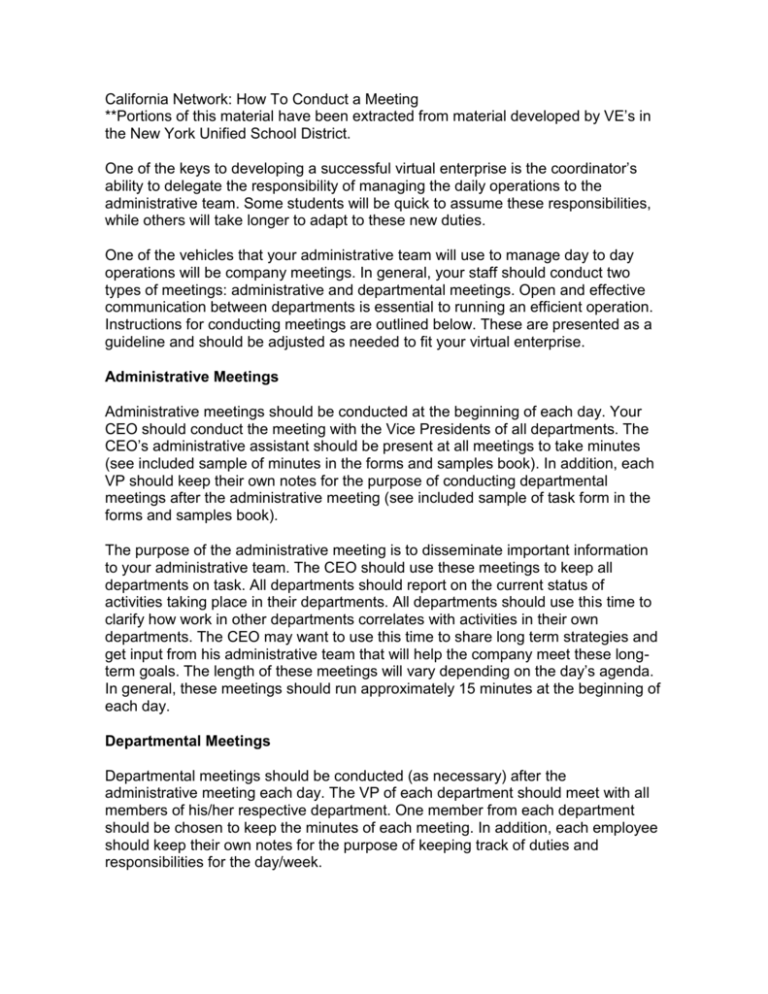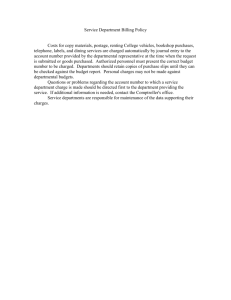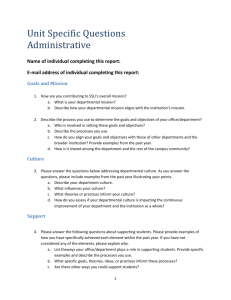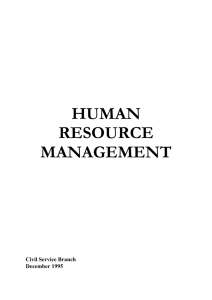California Network: How To Conduct a Meeting
advertisement

California Network: How To Conduct a Meeting **Portions of this material have been extracted from material developed by VE’s in the New York Unified School District. One of the keys to developing a successful virtual enterprise is the coordinator’s ability to delegate the responsibility of managing the daily operations to the administrative team. Some students will be quick to assume these responsibilities, while others will take longer to adapt to these new duties. One of the vehicles that your administrative team will use to manage day to day operations will be company meetings. In general, your staff should conduct two types of meetings: administrative and departmental meetings. Open and effective communication between departments is essential to running an efficient operation. Instructions for conducting meetings are outlined below. These are presented as a guideline and should be adjusted as needed to fit your virtual enterprise. Administrative Meetings Administrative meetings should be conducted at the beginning of each day. Your CEO should conduct the meeting with the Vice Presidents of all departments. The CEO’s administrative assistant should be present at all meetings to take minutes (see included sample of minutes in the forms and samples book). In addition, each VP should keep their own notes for the purpose of conducting departmental meetings after the administrative meeting (see included sample of task form in the forms and samples book). The purpose of the administrative meeting is to disseminate important information to your administrative team. The CEO should use these meetings to keep all departments on task. All departments should report on the current status of activities taking place in their departments. All departments should use this time to clarify how work in other departments correlates with activities in their own departments. The CEO may want to use this time to share long term strategies and get input from his administrative team that will help the company meet these longterm goals. The length of these meetings will vary depending on the day’s agenda. In general, these meetings should run approximately 15 minutes at the beginning of each day. Departmental Meetings Departmental meetings should be conducted (as necessary) after the administrative meeting each day. The VP of each department should meet with all members of his/her respective department. One member from each department should be chosen to keep the minutes of each meeting. In addition, each employee should keep their own notes for the purpose of keeping track of duties and responsibilities for the day/week. The purpose of the departmental meetings is to disseminate important information to all members of your department. The VP of each department should use these meetings to keep all employees on task. All employees should report on the current status of jobs they are currently working on. The VP may want to use this time to pass on important information obtained at the administrative meeting. The VP may want to use this time to assign new tasks/jobs to employees within the department. The length of these meetings will vary depending on the day’s agenda. In general, the meetings should run between 5 to 10 minutes. Instructions for conducting meetings If a meeting is inefficiently run, then nothing is accomplished and it is a waste of time for everyone involved. It is very important that each meeting be run as efficiently and effectively as possible. An agenda should be prepared and followed for each meeting conducted. Minutes should be recorded for each meeting that is conducted. In your opening action, keep your audience focused and alert. Agenda When you plan to conduct a meeting, it is very important to have a schedule of events that are to be discussed during the meeting. This schedule of events is called an Agenda. Every meeting held should have an agenda. For the Administrative Meeting, the CEO (or his administrative assistant) should prepare the agenda – prior to the meeting. For the Departmental Meeting, the VP of each department should prepare the agenda. Most agendas contain the following topics (usually in the following order): 1. Call to Order 2. Attendance 3. Review and Approval of the minutes of the last meeting 4. Old business 5. Committee (or department) reports 6. New business 7. Open discussion period 8. Announcements 9. Reflection 10. Adjournment The agenda should be available to all department members prior to the actual meeting. It is recommended that a copy of the agenda be submitted to the VE coordinator prior to each meeting. Minutes The agenda is not the only important type of documentation for a meeting. Minutes are also important. Minutes are kept of every meeting held. Minutes are the notes taken by a designated member of the meeting (a sample form for minutes can be found in the forms and samples book). The minutes should include: 1. 2. 3. 4. 5. Who attended the meeting Approval of the minutes of the last meeting What was discussed Who was involved in the discussion and what was said The date and time of the next meeting Time Another important factor to consider is time. This is very important to the individuals attending your meeting. Every meeting should be kept to the amount of time allowed for that meeting. If the time designated for a meeting is 30 minutes, that meeting should be kept to that time limit. If a meeting starts to go over the time allowed, the topics should be tabled until the next meeting, unless otherwise decided by the parties involved. If a meeting surpasses its time limit, memebers may lose interest and become uncooperative. Opening Actions In opening or starting to conduct a meeting there are some ideas that you may want to consider. Keep your audience focused – At the beginning of the meeting, start with an effective attention-getter. You can start with a joke, a story, or a startling fact. Make a note of attendance – Keep a list of who does not attend every meeting. This will help you when you may be considering an individual for a special project or just need some help with something else. Review the minutes of last meeting – This will inform everyone of the events at the last meeting and will give everyone a chance to review the minutes. Old Business Old business is items of concern that have been discussed at the meeting previous to the current one. Old business consists of topics that need to be discussed. Make sure that business is important, relevant, and necessary. Committee Reports After all the old business has been discussed, the next order of business is new business. These are generally brief updates about work that is being carried out by members in the company. In these reports an individual may explain the status of a project, a meeting, a problem, or any other departmental issue that is on the agenda. These reports will likely generate new business. New Business After all the committee reports have been presented, the next order of business is new business. These are the topics that have not been discussed at any previous meeting. They may also include new tasks that need to be assigned to department members. New business is handled similar to how old business is handled. The following steps are normally utilized for handling new business: Introduce the new topic or refer to an issue raised in the committee reports. Ask for discussion on the topic. If the issue can be resolved simply, do so. If the issue is more complex, table it for the next meeting. Closing a Meeting To close a meeting, there are only a few tips to follow. Closing a meeting efficiently will give the audience a sense of ending. In that, they should feel that there is no unfinished business that needs to be handled. In closing the meeting: Ask if there is any further discussion of any topics. Summarize the major points of the meeting. Remind the members of the tasks they volunteered to accomplish. Inform the audience of the date, time, and place of the next meeting. Set the agenda for the next meeting. Adjourn the meeting. Other helpful ideas for your meetings: Avoid domination by one person. List ideas first, get one idea per member. Don’t let personality conflicts interfere with the agenda. Recognize that department members have different goals/expectations. Create opportunities to talk about these differences. Your meeting needs to be as interesting as possible. Try to make your meeting even a little fun. It is strongly recommended that you videotape some of your meetings for future training sessions, and to provide feedback to those involved in the meetings. Remember, this will be a learning experience for everyone involved. If enough time is invested in setting these meetings up correctly, the meetings will evolve and the company will run more efficiently.











